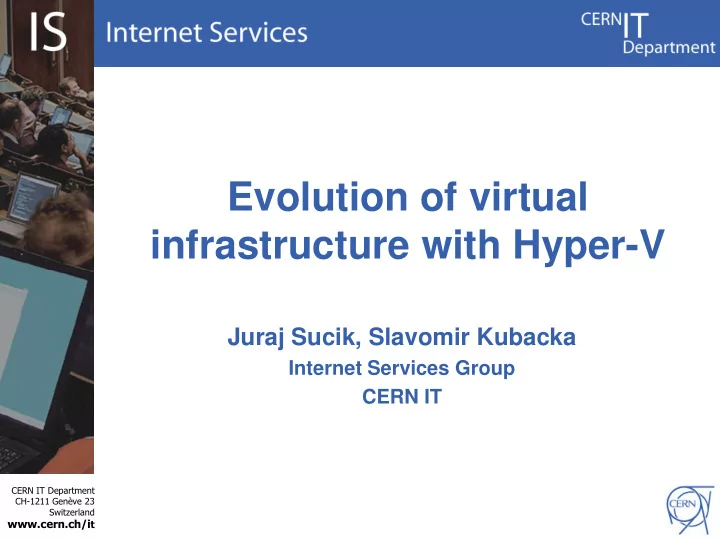

Evolution of virtual infrastructure with Hyper-V Juraj Sucik, Slavomir Kubacka Internet Services Group CERN IT ������������������ ����������������� ����������� ������������� �
Let’s continue… • 2006 � Microsoft Virtual Server 2005 • 2008 � Hyper–V • 2008 • 2008 � SCVMM 2008 • 2009 Sep � Hyper–V 2.0 + SCVMM 2008 R2 ������������������ ����������������� 2 ����������� ������������� �
Hyper-V Features • Hypervisor feature of WS 2008 • 32 and 64-bit virtual machines • Up to 4 CPUs per VM • Max 32 GB of memory per VM • Snapshots • Snapshots • Failover clustering • Scriptable interface ������������������ ����������������� 3 ����������� ������������� �
SCVMM 2008 Features • Enterprise management solution • Windows Powershell API • V2V and P2V capabilities • Web portal • Intelligent placement • Library and templates • Library and templates • Delegated management roles • Job history • Support for highly available VM • VM Migration ������������������ ����������������� 4 ����������� ������������� �
Hyper-V Infrastructure ������������������ ����������������� 5 ����������� ������������� �
System Architecture Application Management CERN Virtual Infrastructure Web Interface Virtual OS Machine Maintenance Manager Admin Backups Backups SOAP Services SOAP Services Console Console Windows Powershell LAN DB Microsoft Virtual Machine Manager 6 ������������������ ����������������� 6 ����������� ������������� �
CERN Virtual Infrastructure ������������������ ����������������� 7 ����������� ������������� �
CERN Virtual Infrastructure ������������������ ����������������� 8 ����������� ������������� �
Enhancements Enhancements ������������������ ����������������� ����������� ������������� �
Hyper-V 2.0 Features • Live migration • Cluster Shared Volume (CSV) � Enables multiple nodes in a cluster to access a single shared LUN � Dynamic I/O redirection • Network optimizations • Network optimizations • TCP/IP Traffic in a VM can be offloaded to a physical NIC on the host computer • Processor compatibility mode • Allows live migration across different CPU versions within the same processor family ������������������ ����������������� 10 ����������� ������������� �
Hyper-V 2.0 Features • Logical Processor Support � Support for 32 logical processors on host computer • Hot Add/Remove Storage � Add and remove VHD disks to a running VM without requiring a reboot without requiring a reboot • Second Level Translation (SLAT) • Leverage new processor features to improve performance and reduce load on Windows Hypervisor • Better SMP support for Linux ������������������ ����������������� 11 ����������� ������������� �
SCVMM 2008 R2 Features • Manage WS 2008 R2 Hyper-V • Live Migration • Detects if Live migration can be done • Maintenance mode • Placement of new VM not allowed • Placement of new VM not allowed • Existing VMs migrated off or saved • Multiple VM per LUN using CSV • Supports CSV feature of HV 2.0 • V2P feature ������������������ ����������������� 12 ����������� ������������� �
SCVMM 2008 R2 Features • SAN related enhancements • Promote non-HA VM to HA VM by migrating it to a clustered host, and vice versa to “demote” the VM • Network optimizations • If enabled, VMM will configure the VM to • If enabled, VMM will configure the VM to use VMQ or Chimney, if available on the host • Rapid provisioning • Avoids copying VHD from library • VDI integration ������������������ ����������������� 13 ����������� ������������� �
Why Migration? • Maintenance reasons • Load balancing • Green IT • Fast migration • SOAP interface • SOAP interface ������������������ ����������������� 14 ����������� ������������� �
Live Migration • No dropped network connections • No perceived loss of service • Clustered Shared Volumes facilitates LM • Leverages Failover Clustering ������������������ ����������������� 15 ����������� ������������� �
Quick vs. Live Migration Quick Migration (Windows Server 2008 Hyper-V) Save state 1. Create VM on the target • Write VM memory to shared storage • Move virtual machine 2. Move storage connectivity from source Move storage connectivity from source • • host to target host via Ethernet Restore state & Run 3. Take VM memory from shared storage • and restore on Target Run • ������������������ Host 2 Host 2 Host 1 Host 1 ����������������� 16 ����������� ������������� �
Quick vs. Live Migration Live Migration (WS08R2 Hyper-V) VM State/Memory Transfer 1. Create VM on the target • Move memory pages from the source to the target • via Ethernet Final state transfer and virtual machine restore 2. Pause virtual machine • Move storage connectivity from source host to • target host via Ethernet Un-pause & Run 3. ������������������ ����������������� Host 2 Host 2 Host 1 Host 1 17 ����������� ������������� �
VMware vs. Hyper-V R2 Aspect vSphere 4 Hyper-V R2 # CPU core 64 64 Memory 1TB 2TB # nodes in cluster 32 16 # virtual CPU 8 4 # guest per host 256 192 Virtual memory Virtual memory 256GB 256GB 64GB 64GB Hot-add disk Yes SCSI only VM move Live Live # of snapshots 32 50 HA via clustering Yes Yes Market share 44% 23% Source: Login, USENIX Magazine, Oct 2009 ������������������ ����������������� 18 ����������� ������������� �
Hyper-V Linux VM • RHEL supported as guest OS • Open source drivers (GPL) in 2.6.32 • CPU Benchmark HEP - SPEC Benchmark 80 70 60 50 40 Hyper-V 2.0 30 Hyper-V 1.0 20 10 0 8-core PH 1-core 1GB 2-core 2GB 4-core 4GB VM VM VM ������������������ ����������������� 19 ����������� ������������� �
Linux in VM • Time synchronization � Kernel parameters, e.g. notsc divider=10 • Virtual serial console • Admin privileges Operating systems running in VM • 5 Linux templates • 5 Linux templates 6% 6% 6% 31% Linux 32-bit Linux 64-bit Windows 32-bit Windows 64-bit 57% ������������������ ����������������� 20 ����������� ������������� �
Consolidation vs. batch Aspect Service Batch consolidation virtualization Scale (machines) ~ 100 ~ 1000 CPU usage CPU usage Little Little High High Hardware Reliable Cheap Services Critical Non-critical Migration Live Not required VM life time Long Limited ������������������ ����������������� 21 ����������� ������������� �
ELFms Integration Perl SOAP client Application HMS Management AIMS Virtual OS Lemon Machine Maintenance Manager Admin Backups Backups SOAP Services SOAP Services Console Console Windows Powershell LAN DB Microsoft Virtual Machine Manager 22 ������������������ ����������������� 22 ����������� ������������� �
Recommend
More recommend